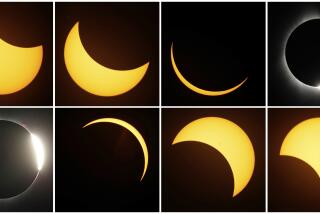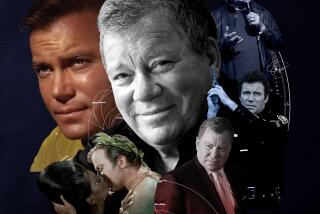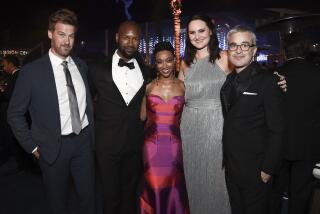‘Cosmos’ recap: It’s all relative except PATRICK STEWART!
This week’s episode of Cosmos paid tribute to the mind-bending science behind some of the most popular tropes in science fiction, so it’s only fitting that it also featured a special cameo by none other than Patrick Stewart. Stewart is best known to his legion of fans as Star Trek’s Captain Jean-Luc Picard. (That high-pitched sound you hear is a collective “squee!” from my fellow geekerati.)
Stewart voices astronomer William Herschel in an animated sequence set in 1802, as Herschel walks along the beach at night with his young son, John. The boy asks his father if he believes in ghosts, and surprisingly, Herschel says yes -- although by “ghosts,” he means the light he can see through his telescope. He explains that this is light that first emanated from long-dead stars. The telescope is a kind of time machine in that respect, because it takes so long for light to travel from those most distant stars to Earth today.
In fact, as host Neil de Grasse Tyson tells us, there is a one-second delay in the light we see reflecting off the moon. Technically, we’re seeing the moon as it was one second in the past.
PHOTOS: WGA’s top 101 TV shows
“Seeing is not believing; our senses can deceive us,” Tyson warns. It’s natural to assume we are the center of the universe, because that’s how it seems when we gaze out into the vastness of space. But this too is an illusion: There is no fixed center of the universe. Everything is in motion relative to everything else. And that brings us to Albert Einstein, who first started thinking about the dynamic universe and the speed of light in the summer of 1895, while vacationing in Italy.
In Einstein’s theory of special relativity, the speed of light is the only constant. It’s the cosmic speed limit: No object with mass can ever reach the speed of light. The protons used in the Large Hadron Collider can accelerate to within 99.999% of the speed of light, but never actually reach the exact speed, and they certainly can’t break that barrier.
Things get really weird the closer we get to the speed of light -- specifically, space and time warp (at least from the perspective of an outside observer) to ensure that the speed of light always stays constant. A ruler would get shorter, for instance, and “our biological clock slows down relative to those we leave behind,” Tyson intones. He’s talking about the famous “twin paradox”: If one identical twin jumps in a spaceship and zooms off to explore outer space at near the speed of light, while the other stays behind, when the traveling twin returns, he will be shocked to find his brother has aged far more rapidly -- because time passed more slowly for him than for his twin.
This is one of the niftiest paradoxes in physics, and I’m frankly surprised the episode didn’t have more fun with it. I mean, imagine an animated sequence in which Herschel jumped in a rocketship and returned to find he was now younger than his own son. Special relativity has some freaky implications; why not explore them?
PHOTOS: Behind the scenes of movies and TV
Gravity also affects light in interesting ways. Einstein explained that gravity is the result of the warping of spacetime in response to the mass of celestial bodies -- the denser the object, the more extreme said warping will be, and the stronger the gravitational effects. We revisit the Herschels as William tells his son about another astronomer named John Mitchell, who first proposed the existence of “dark stars.” Today, we call such objects black holes.
Black holes have such extreme gravity that not even light can escape once it passes the event horizon. Time gets wonky too: The person crossing the event horizon might not notice anything amiss, but if we were watching that person from a distance, they would appear frozen in time forever at that horizon.
In the spirit of great thought experiments in physics, Tyson and his Ship of Imagination dive in for an extended visual sequence of what we might see as we traveled through a black hole. Technically, we probably wouldn’t survive. We’d be torn apart by the intense gravity long before we reached the singularity, a point of infinite density inside the black hole.
The technical term is “spaghettification” because the force on our feet would be so much greater than the force on our heads that we would be stretched into spaghetti. (Alternatively, we could burn up in a wall of fire as we crossed the event horizon. Take your pick.)
But the Ship of Imagination can defy the laws of physics, and we are treated to a wacky light show of sorts, until suddenly we reemerge from the black hole and find ourselves reliving the episode’s opening animated sequence with young John asking his father, “Do you believe in ghosts?”
PHOTOSD: TV shows and their spinoffs
I SEE WHAT YOU DID THERE, COSMOS! It’s a nod to the notion Carl Sagan devised in his novel “Contact” -- working with physicist Kip Thorne on the science -- for how one might use wormholes (basically black holes with an opening at the singularity) to travel across vast distances in space in far less time than it would take if we just went the direct route -- even traveling at warp speed, like the Enterprise. The intense gravity would bend spacetime so severely, otherwise distant spots could actually connect. And because space and time are one, it might also allow us to travel back in time. Sure, it’s speculative, but black holes could turn out to serve as tunnels through the universe, forming what Tyson dubs an “intergalactic subway system.”
This episode should be popular, because it touched on some of the biggest, most mind-bending ideas in physics -- and also PATRICK STEWART! Unfortunately, it didn’t really do justice to those ideas -- and that’s a shame.
There was a particularly mystifying sequence involving Herschel’s discovery of binary stars, Newton’s inability to explain gravity’s “action at a distance” and the work of Michael Faraday and James Clerk Maxwell on unifying electricity and magnetism, which is why there is light. All these things are related, but the connections are sketched so thinly that viewers might understandably not grasp them.
These are big ideas; take some time to unpack the concepts a little and explore them. The ghost of Carl Sagan would approve.
ALSO:
‘Cosmos’ recap: Starts with a big bang
Review: Neil deGrasse Tyson’s ‘Cosmos’ a fascinating, fun place to be
Watch ‘Cosmos’ Q&A with Neil deGrasse Tyson and Seth MacFarlane
More to Read
The complete guide to home viewing
Get Screen Gab for everything about the TV shows and streaming movies everyone’s talking about.
You may occasionally receive promotional content from the Los Angeles Times.






